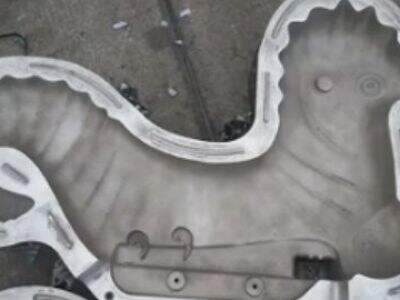Mi, a Young Mould-nél azt gondolvjuk, hogy az anyagválasztás döntő jelentőségű a rotomoldolási moldokban. Tól a játékokig a nehézgépészeti berendezések komponenseiig mindent keresztül a rotomoldolással gyártanak. Ez azt jelenti, hogy egy üres moldot melegítünk, majd a ből megforrósodott plastikot forgatjuk, amíg felmelegedik és lehűl. Ez irányítja a plastikot a végtermékbe. Ezen a folyamaton keresztül a gyártáshoz használt magas minőségű moldok sokat hoznak hozzá a erősségehez és merevséghez. Ha a moldok erősnek tekinthetők, akkor segítenek abban, hogy konzisztensan jó minőségű termékeket gyártanak.
Az anyagválasztás hatása a rotomoldolási moldokra
A rotomolding formák tervezésének egyik kulcsfontosságú szempontja a anyagválasztás. A megfelelő anyag kiválasztása a tervezési folyamat egy kritikus eleme. Az általunk használt anyag típusa közvetlenül meghatározza, hogy mennyit tart a forma, mennyi kihasználható terhelést bír el, valamint hogy milyen termékek gyártása lehetséges. Ha nem tesszük megfelelően, hogy a forma erős elegendő anyagból legyen készítve, akkor a termékek gyártása nem lesz jó. Ez immenso mennyiségű hulladékot eredményez, ami azt jelenti, hogy több anyag végzene a takarékosztályokban. Emiatt lassulhat a termelési sebesség, vagyis hogy mennyire gyorsan lehet elkészíteni a termékeket, és növelheti a javítási költségeket, ha valami elromlik.
Anyagválasztási lehetőségek a rotomoldinghoz
A megfelelő rotomoldozási formanyerszeres anyag kiválasztásához több tényezőt kell figyelembe venni. Vegyük fel, hogy a forma méretét és alakját, valamint a termék típusát ismerhetjük, hogy ezeket a számításokat elvégezzük. A kiválasztott anyagoknak elegendően tartósaknak kell lenniük, hogy kiálljanak a melegítés és hűtés magas hőmérséklere. Néhány gyakran használt anyag a rotomoldozási formákban olyanok, amelyek specifikus előnyöket kínálnak. Az alumínium például erős, könnyű és könnyen dolgozható. Összetett alakzatokba is egyszerűen alakíthatók. A vasformák viszont rendkívül tartósak, éveken át használhatók, ami nagyon jól alkalmas nehéz munkavégzésre. Végül a teréblyes formák általánosan a legolcsóbbak, különösen a kis mennyiségű termékek esetén. Ezek alkalmasak minimális termelési igényekkel rendelkező projektekhez.
Anyagszempontok hatása a forma teljesítményére
A anyag, amelyet választunk egy rotomoldolásra alkalmas formához, nagy szerepet játszik annak a teljesítményében. Két csoportba oszthatóak az anyagi tulajdonságok: az egyikben jól meghatározott hőmérsékleti, a másikban pedig jól definiált mechanikai tulajdonságok vannak. A hőmérsékleti tulajdonságok az anyag képességére utalnak arra, hogy magas hőmérsékletet bírjon el anélkül, hogy deformálódna vagy károsodna. Például, a rotomoldolás nagyon jól működik olyan anyagokkal, amelyek magas hőtűlterjedési toleranciával rendelkeznek, anélkül, hogy lemelegnének, összecsúsznának vagy törékenyek lennének. A mechanikai tulajdonságok azonként kapcsolódnak ahhoz, hogy milyen erős és támasztó egy anyag lehet. A moldolás során fellépő nyomás és impaktus csak erős anyagok, mint például a vas vagy az alumínium tudja kezelni őket. Ez azt jelenti, hogy sokkal kevesebb eséllyel történik károsodás vagy sértés, amikor termékeket gyártanak.
Miért fontos a megfelelő anyag kiválasztása?
Egy másik gyakori rotomoldozási hiba akkor fordul elő, amikor az emberek nem veszik komolyan a anyag kiválasztását. Sok gyártó több figyelmet fordít a mold kinézetére és a mold tervezésére, mint a anyag sajátosságaira magukban. Ez számos problémát okozhat. Például, ha a kiválasztott anyag nem alkalmas, gyakrabban lehet szükség javításokra. Ez azt jelenti, hogy pénzt és időt kell költeni a dolgok javítására, helyett, hogy termékeket gyártana. Emellett a helytelen anyag használata növelheti a termelési időt, ami azt jelenti, hogy több idő telik el a termékek ügyfelekhez való kézbesítéseig. Végül változó termékminőségre vezethet, amelyben néhány termék jó, mások viszont nem. Ennélfogva a rotomoldozási mold anyag kiválasztása nagyon kritikus tényező. Ez lehetővé teszi a jobb teljesítményt, alacsonyabb költségeket és hatékonyabb termelést.
Anyagkiválasztás jobb mold teljesítmény érdekében
A rotomolding formák teljes kihasználásának kulcsa: a megfelelő anyag kiválasztása. Az anyag kiválasztása nagyon attól függ, hogy milyen tervezésű a forma, mi a termék típusa és milyen környezeti feltételek vannak. A Young Mouldnál elsősorban prémium anyagokat használunk minden olyan terméken, amelyet mestersegesek gyártanak. Ez a szorgalmi kiválasztás nemcsak lehetővé teszi nekünk, hogy minőségi termékeket adjunk át időben, hanem jelentősen csökkenti a javítási és karbantartási költségeket is.
Összefoglalólag, a megfelelő anyag kiválasztása egyik kulcsa a rotomolding másképek sikeres működéséhez. Minőségi termékek esetén az a megfelelő anyagválasztás alapvetően fontos a máskép tervezéséhez, a törékeny termékhez és a termék használati környezetéhez. Ez lehetővé teszi a költségmegtakarítást és a karbantartási igények csökkentését. A Young Mould-nél mindig a minőségi anyagok érintik a legfontosabb prioritásainkat és másképeinket, az anyagválasztás csak egy példa arra, hogy hogyan kötelezzük el magunkat arra, hogy felsőbb minőségű termékeket és szolgáltatásokat nyújtsunk vásárlóinknak a rotomolding iparágban. Így építhetünk kapcsolatot a vásárlóinkkal és garantálhatjuk jóváhagyásukat a termékeinkre.
 EN
EN
 AR
AR
 BG
BG
 HR
HR
 CS
CS
 DA
DA
 NL
NL
 FI
FI
 FR
FR
 DE
DE
 EL
EL
 HI
HI
 IT
IT
 JA
JA
 KO
KO
 NO
NO
 PL
PL
 PT
PT
 RO
RO
 RU
RU
 ES
ES
 SV
SV
 ID
ID
 LV
LV
 LT
LT
 SR
SR
 SL
SL
 VI
VI
 SQ
SQ
 ET
ET
 HU
HU
 TH
TH
 TR
TR
 AF
AF
 GA
GA
 CY
CY
 BE
BE
 LA
LA
 UZ
UZ


